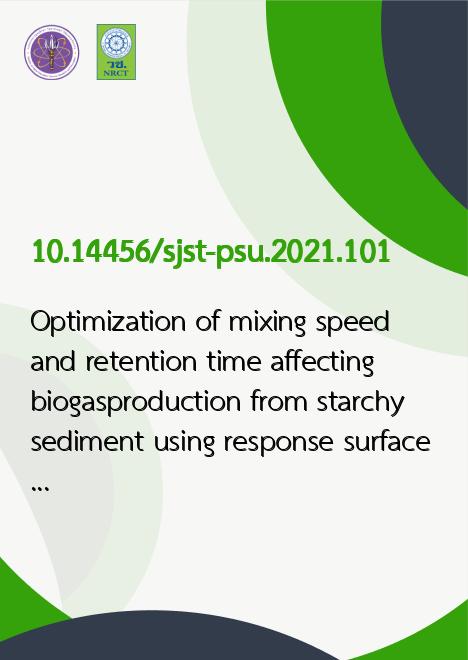
|
Optimization of mixing speed and retention time affecting biogasproduction from starchy sediment using response surface methodology |
|---|---|
| รหัสดีโอไอ | |
| Creator | 1. Piyavadee Srivichai 2. Sakesun Thongtip |
| Title | Optimization of mixing speed and retention time affecting biogasproduction from starchy sediment using response surface methodology |
| Publisher | Research and Development Office,Prince of Songkla University |
| Publication Year | 2564 |
| Journal Title | Songklanakarin Journal of Science and Technology (SJST) |
| Journal Vol. | 43 |
| Journal No. | 3 |
| Page no. | 767-773 |
| Keyword | biogas, mixing speed, retention time, response surface methodology, biochemical methane potential |
| URL Website | https://rdo.psu.ac.th/sjstweb/ |
| ISSN | 0125-3395 |
| Abstract | The purpose of this research is to investigate the effects of mixing speed (MS) (5-175 rpm) and retention time (RT) (1-35 days) on biogas production of starchy sediment (SS) that is substantial waste from the modified tapioca starch plants. The ADwas performed using biochemical methane potential (BMP) method. The two factor central composite design (CCD) has beenemployed to design and response surface methodology (RSM) used to evaluate the digestion efficiency and performance. Thebiogas yield (BY) can be as high as 403 ml/g TVSadded at an MS:RT ratio of 112:30, whereas the TVS removal measures equal to65.07%. It indicated that the SS could be applied as the suitable substrate for AD by operating with this MS:RT ratio. However,the signs of initial system instability were detected. It requires the further study about pH control by adding the chemical tomaintain the proper stability. |
